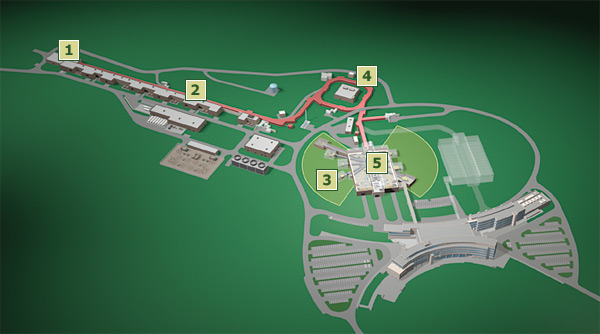Deconstruction: Spallation Neutron Source
Neutron scattering research has improved the quality of many everyday items: Shatter-proof windshields, credit cards, pocket calculators, airplanes, compact discs, and magnetic storage tapes are just some examples. Probing materials and biological samples with neutrons, scientists have learned more about high-temperature superconductors, aluminum bridges, lighter and stronger plastic products, and pharmaceuticals. The increasing demand for more and better neutron sources has led to the construction of the Spallation Neutron Source (SNS) at Oak Ridge National Laboratory in Tennessee, designed and built by a partnership of six US Department of Energy national laboratories.
Six national laboratories–Argonne, Brookhaven, Jefferson, Lawrence Berkeley, Los Alamos, and Oak Ridge–designed and built the Spallation Neutron Source, which cost US$1.4 billion. Funded by the Office of Science of the Department of Energy, the construction of the facility took seven years; the first production of neutrons took place on April 28, 2006. The SNS is open to scientists and engineers from universities, industries, and government laboratories in the United States and abroad.
 |
| Graphic: Spallation Neutron Source Text: Kurt Riesselmann; SNS fact sheet |
| 1 |
Neutrons are the neutral building blocks found inside atomic nuclei. To produce beams of neutrons, scientists accelerate charged particles and smash them into heavy atomic nuclei containing lots of neutrons. The collisions shake loose the neutrons in a process called spallation. At the SNS, a front-end system provides a stream of negatively charged hydrogen ions (each ion consisting of one proton and two electrons). |
| 2 |
The linear accelerator of the SNS, about 330 meters long, speeds up the hydrogen ions with electric fields that provide a cumulative voltage of one billion volts. Along the way, a foil strips the electrons from the ions, leaving behind a beam of protons. The SNS linac is the first machine to accelerate protons using superconducting technology, featuring doughnut-shaped cavities that conduct electrical currents without resistance. Operating at a temperature close to absolute zero, these high-tech devices provide extremely efficient acceleration, minimizing the length of the SNS proton accelerator. |
| 3 |
The target area is surrounded by experimental stations with "instrument systems" that use neutrons for scientific experiments and industrial development. When complete, the Spallation Neutron Source will accommodate 24 experimental areas, used by researchers in physics, chemistry, biology, materials science, and engineering. In contrast to X-rays, which cannot penetrate metal or dense materials, neutrons traverse virtually all types of materials. With neutrons, scientists can determine molecular structures and observe the motion of atoms. The brightness of the SNS will yield snapshots with higher resolution than achieved at older neutron sources, and the high repetition rate of the SNS neutron pulses will allow for the recording of "movies" of molecules in motion. |
| 4 |
Neutron sources based on nuclear reactors provide a steady stream of neutrons. In contrast, acceleratorbased neutron sources such as the SNS can provide pulses of neutrons. To create pulses, the SNS has a storage–or accumulator–ring that collects the protons emerging from the linac close at the speed of light and sends them a short time later, when enough protons have accumulated, to a neutron-rich target. |
| 5 |
In the target hall, sixty times per second, batches of protons strike a container filled with liquid mercury. Like a baseball hitting a bucket filled with tennis balls, each proton entering the mercury causes the emission of neutrons: some neutrons are ejected immediately with high speeds; other neutrons rattle around for a while before leaving the mercury container at lower speeds. For every proton striking a mercury nucleus, about 20 neutrons are expelled. |
Click here to download the pdf version of this article.






